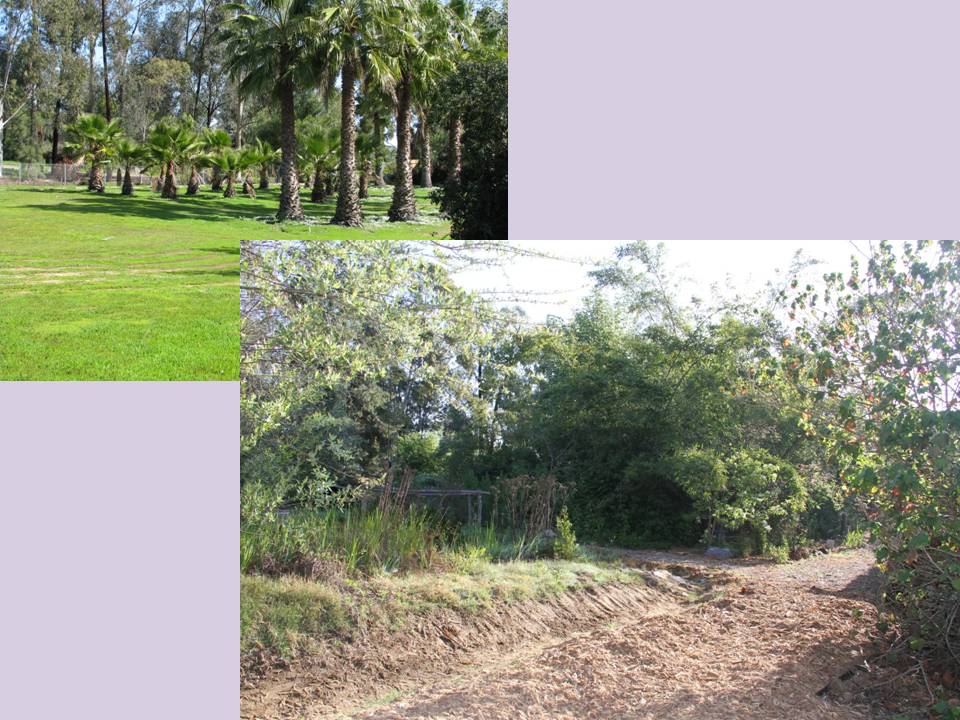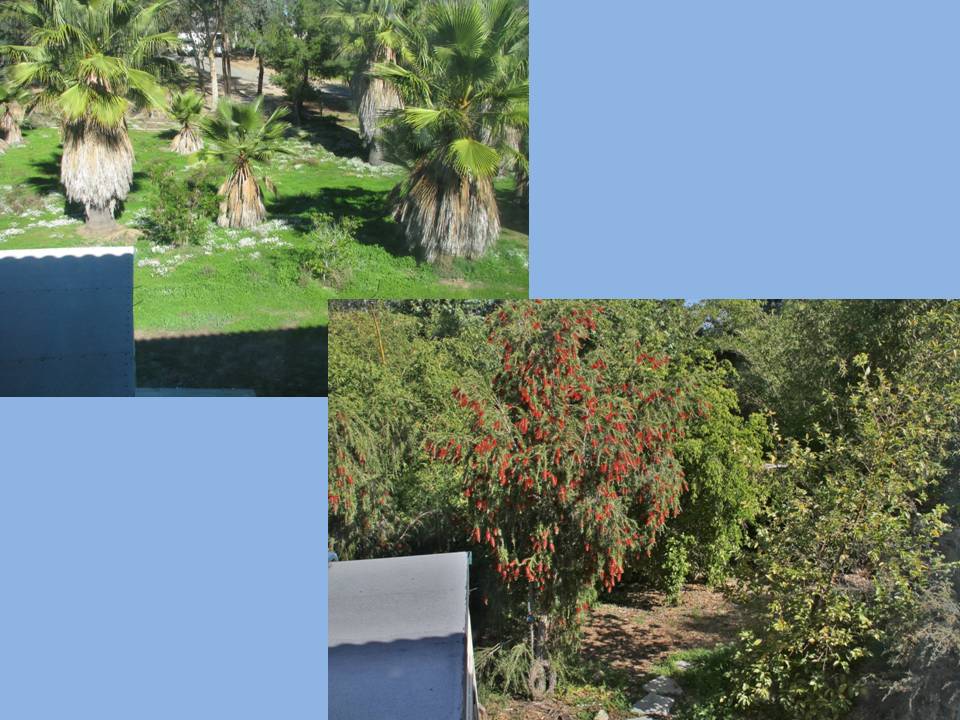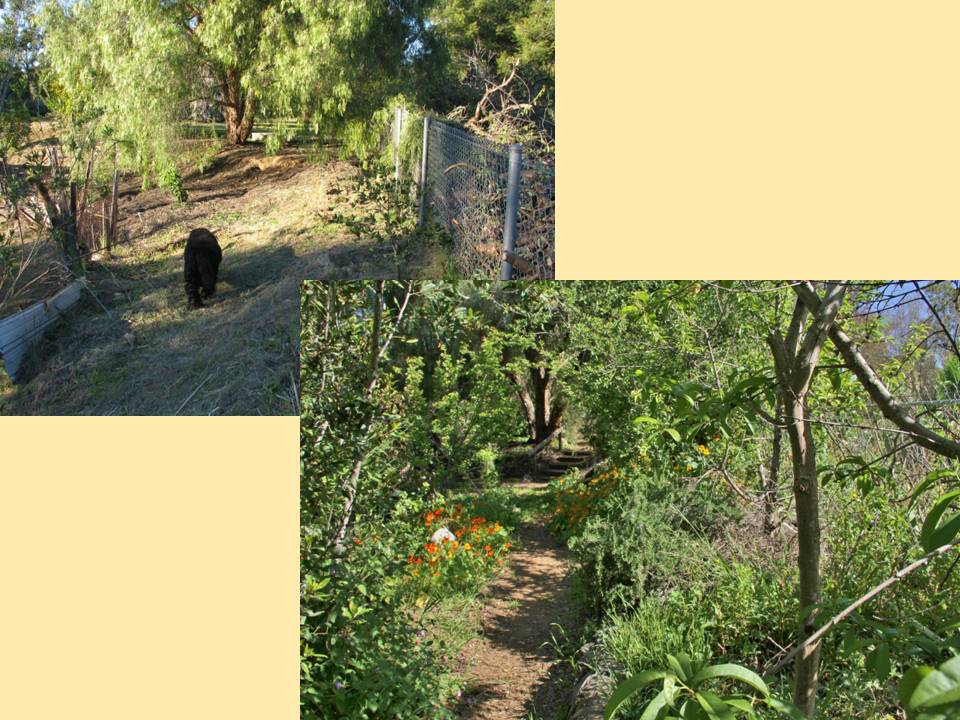Water Saving
- Animals, Arts and Crafts, Bees, Birding, Building and Landscaping, Chickens, Fungus and Mushrooms, Gardening adventures, Heirloom Plants, Hugelkultur, Microbes and Fungi, Natives, Other Insects, Perennial vegetables, Permaculture and Edible Forest Gardening Adventures, Photos, Ponds, Rain Catching, Recycling and Repurposing, Soil, Water, Water Saving
Six Years of Permaculture

 In February, 2011, I signed the contract with Roger Boddaert to create a permaculture food forest. The goals at that time were to stop the erosion on the property, to create a wildlife habitat, and to grow food, medicine, native plants, building materials, herbs and ornamentals in a sane way: no chemicals. So the journey began, and it hasn’t been easy. Nor did I at that time know that the garden would evolve into Finch Frolic Garden and my business would be education.
In February, 2011, I signed the contract with Roger Boddaert to create a permaculture food forest. The goals at that time were to stop the erosion on the property, to create a wildlife habitat, and to grow food, medicine, native plants, building materials, herbs and ornamentals in a sane way: no chemicals. So the journey began, and it hasn’t been easy. Nor did I at that time know that the garden would evolve into Finch Frolic Garden and my business would be education. In preparing for a talk about our garden, Miranda and I worked on before and after photos. The garden this April, 2017, is stunning, with blooming wisteria, fruit trees, red bud, roses, angel-wing jasmine, iris, and so much more. Best of all Mrs. Mallard has brought her annual flock of ducklings from wherever she nests, and the four babies are still alive and thriving after a week! So I thought I’d share the incredible difference between what had been, and what is now. All done with low water use, no fertilizer, herbicide, insecticide, additives or supplements. Come visit when you can! Slideshow images change in ten seconds:
- Building and Landscaping, Compost, Gardening adventures, Hugelkultur, Irrigation and Watering, Natives, Permaculture and Edible Forest Gardening Adventures, Ponds, Rain Catching, Soil, Water, Water Saving
Installing a Swale
 Last Saturday we hosted our first workshop of 2017, featuring Alden Hough of Sky Mountain Permaculture. Alden is a master at creating earthworks, and he spent three hours here at Finch Frolic Garden teaching a class of sixteen people how to install swales correctly.
Last Saturday we hosted our first workshop of 2017, featuring Alden Hough of Sky Mountain Permaculture. Alden is a master at creating earthworks, and he spent three hours here at Finch Frolic Garden teaching a class of sixteen people how to install swales correctly. 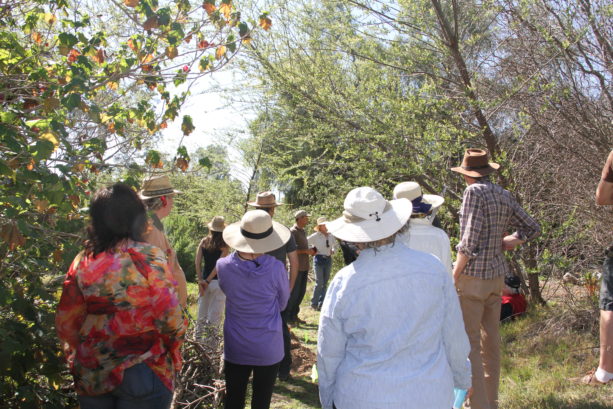 The project was a small pond that overflowed and flooded when heavy rains hit. The soil is heavy clay and therefore the small pond doesn’t percolate. It is kept filled by the well, and its overflow feeds the bog and the big pond. Right now the little pond is full of native Pacific chorus frog tadpoles, which will evolve into small frogs that will go out into the landscape and eat bugs the rest of the year.
The project was a small pond that overflowed and flooded when heavy rains hit. The soil is heavy clay and therefore the small pond doesn’t percolate. It is kept filled by the well, and its overflow feeds the bog and the big pond. Right now the little pond is full of native Pacific chorus frog tadpoles, which will evolve into small frogs that will go out into the landscape and eat bugs the rest of the year.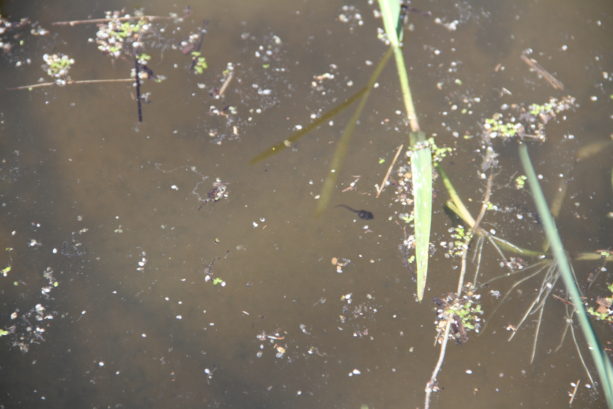 He created a urbanite (cement chunks) spillway into a twenty-foot swale. The class learned what a bunyip was and how to use the water level, and how to use a laser level. The swale will hold about 300 gallons of water that would have overflowed into another area, spread and sink the water.
He created a urbanite (cement chunks) spillway into a twenty-foot swale. The class learned what a bunyip was and how to use the water level, and how to use a laser level. The swale will hold about 300 gallons of water that would have overflowed into another area, spread and sink the water. 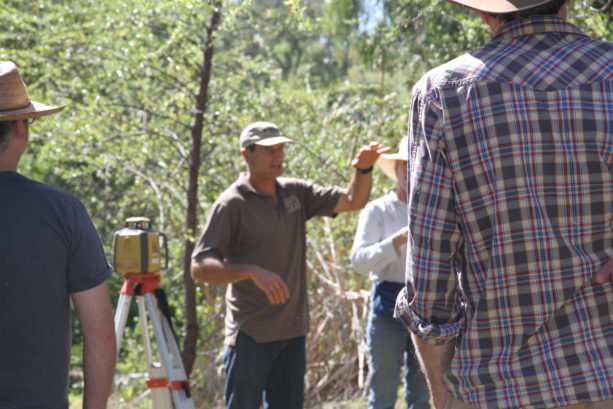
The swale was measured and marked on contour.
 Bermuda grass was pulled from it and set into trash cans to cook in the sun and hopefully be destroyed. The swale was then dug by hand.
Bermuda grass was pulled from it and set into trash cans to cook in the sun and hopefully be destroyed. The swale was then dug by hand. Old wood – branches, logs, boards and old posts – were laid below the swale, and covered by the dirt. This hugelkultur will absorb seeping water, aerate and enrich the soil, and provide food and water over time for the trees downhill.
Old wood – branches, logs, boards and old posts – were laid below the swale, and covered by the dirt. This hugelkultur will absorb seeping water, aerate and enrich the soil, and provide food and water over time for the trees downhill.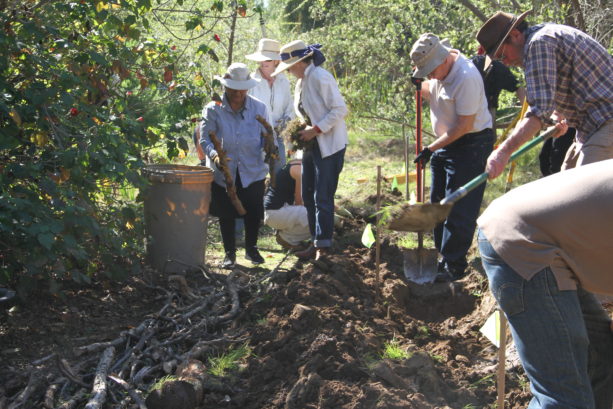 More dirt was needed to cover the wood so we emptied the first rain catchment basin on the property of silt and hauled it down the hill. This was a lot of heavy work, and several of our attendees worked extremely hard with the wheelbarrows. Miranda and I have a lot of experience doing this heavy work, and we are glad that this swale project also emptied this basin.
More dirt was needed to cover the wood so we emptied the first rain catchment basin on the property of silt and hauled it down the hill. This was a lot of heavy work, and several of our attendees worked extremely hard with the wheelbarrows. Miranda and I have a lot of experience doing this heavy work, and we are glad that this swale project also emptied this basin. Our wonderful workshop attendees worked very hard in the heat. The end result was a swale of beauty.
 By creating level swales dug on contour, you can see how right it looks. It hasn’t been dug deeper into the ground at one end to force the swale to be level. If you measure on contour your swale can be of any size, and it will collect, passify, spread and sink rainwater into the landscape. Earthworks are the best way to hold water, and are imperative to reestablishing water tables, keeping wells running, keeping trees alive and maintaining springs and streams. A little earthworks will make a huge difference.
By creating level swales dug on contour, you can see how right it looks. It hasn’t been dug deeper into the ground at one end to force the swale to be level. If you measure on contour your swale can be of any size, and it will collect, passify, spread and sink rainwater into the landscape. Earthworks are the best way to hold water, and are imperative to reestablishing water tables, keeping wells running, keeping trees alive and maintaining springs and streams. A little earthworks will make a huge difference.What needs to be done now is to create a dedicated overflow from the swale into the main pond. As this area receives a lot of foot traffic, we’ll also need to haul more silt to make the raised walkway more gradual and blended with the paths around. Once the tadpoles have grown and left the pond, we can drain it and use that silt. Two projects in one.
Prior to the project Miranda carefully removed a lot of healthy creeping red fescue from the work site. After the swale and spillway were dug she replanted some of it. Native yarrow will also be planted to help hold the swale.
A huge thanks to the many people who came to learn and work on site. No matter how many movies you watch or books you read, having hands-on experience makes the education click. And an extra huge thanks to Alden Hough for his expertise and hard work. Please visit Sky Mountain Permaculture in Escondido for more classes – earth bag dome building included – coming up there.
Our next Finch Frolic Garden workshop will be in April: April 22, 2pm – 4pm: The Many Benefits of Trees: Care, Nurturing and Pruning . Roger Boddaert, the Tree Man of Fallbrook and professional landscaper who planned the original garden that would evolve into Finch Frolic Garden, will talk about trees. So many trees are dying due to the drought, and we need to replace them to help shade and cool the earth and hold onto moisture. But what to plant, where and how to care for them? Roger will take you through tree care based on fifty years of experience in landscaping. Visit https://www.southernpalmetto.com/services/ and get all the details.
Go forth and dig swales!
- Building and Landscaping, Compost, Gardening adventures, Hugelkultur, Irrigation and Watering, Permaculture and Edible Forest Gardening Adventures, Rain Catching, Soil, Water, Water Saving, Worms
Earthworks Workshop
Happy March! Finch Frolic Garden is officially open, and the trees are bursting into leaf and bloom. Birds are twitterpating and the ten inches of rain we’ve received since October are slowly working through the soil thanks to our earthworks.
Here’s an opportunity to learn just how to create accurate swales and hugelkultur so that they work. Saturday March 11th from 1 -4 we have the privilege of having Alden Hough from Sky Mountain Permaculture hold our first monthly workshop here in the garden. Alden has
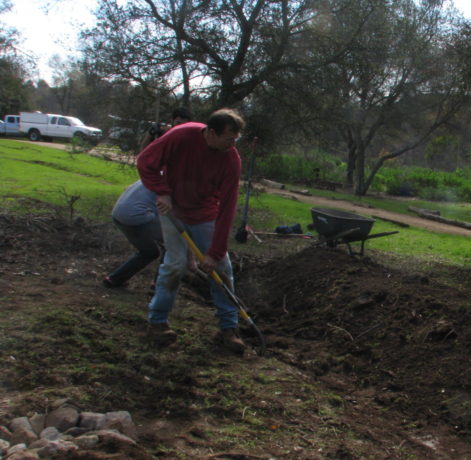 years of experience with building earthworks on all scales, from guiding excavators across hillsides to hand-dug. Alden will describe how to build swales and hugelkultur beds, show off equipment, and then its hands-on in the garden. You’ll learn how to use a laser level and a bunyip, and get the feel of how to build on contour. Bring your gloves and be prepared to have some fun creating earthworks, so that you can do it properly on your own property.
years of experience with building earthworks on all scales, from guiding excavators across hillsides to hand-dug. Alden will describe how to build swales and hugelkultur beds, show off equipment, and then its hands-on in the garden. You’ll learn how to use a laser level and a bunyip, and get the feel of how to build on contour. Bring your gloves and be prepared to have some fun creating earthworks, so that you can do it properly on your own property.The workshop fee is $20/person. Please RSVP to dianeckennedy@prodigy.net. Wear appropriate work clothes and sun protection. Complimentary vegetarian refreshments will be available. Attendees may stroll Finch Frolic Garden as well. Don’t wait!
- Compost, Gardening adventures, Hugelkultur, Irrigation and Watering, Permaculture and Edible Forest Gardening Adventures, Ponds, Rain Catching, Seeds, Soil, Water, Water Saving
Swales and Basins in Action!
 This week here in Fallbrook, CA, at Finch Frolic Garden we received almost three inches of rain in 18 hours. Our storm pattern is changing so that there are fewer rain events, but when it rains, it really rains.
This week here in Fallbrook, CA, at Finch Frolic Garden we received almost three inches of rain in 18 hours. Our storm pattern is changing so that there are fewer rain events, but when it rains, it really rains. 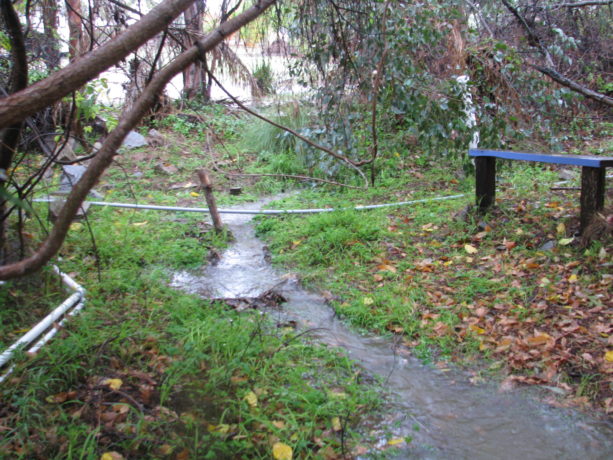 For many this was a flood. Precious rainwater is channeled away from properties and into the street. In permaculture gardens the water is harvested in the earth with simple earthworks such as swales (level-bottomed ditches) and rain catchment basins.
For many this was a flood. Precious rainwater is channeled away from properties and into the street. In permaculture gardens the water is harvested in the earth with simple earthworks such as swales (level-bottomed ditches) and rain catchment basins.Visitors have often expressed their desire to see the earthworks in action, so I took my camera out into the food forest.
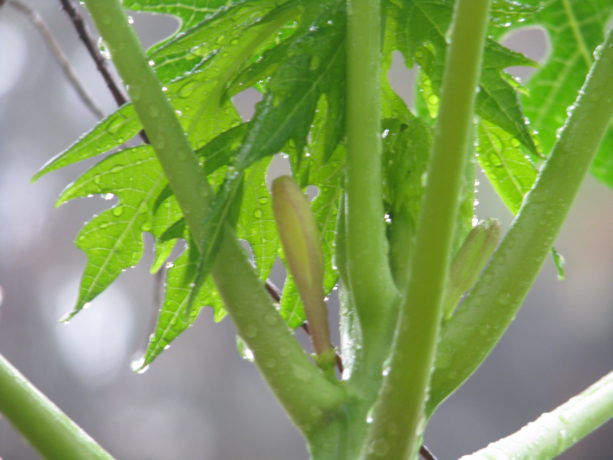 That was when the rain gauge was at about two and three quarters, with more to come. (I wanted to photograph the garden after the storm had passed but my camera refused to turn on due to the indignity of having been wet. A couple of nights in a bag of rice did it wonders.)
That was when the rain gauge was at about two and three quarters, with more to come. (I wanted to photograph the garden after the storm had passed but my camera refused to turn on due to the indignity of having been wet. A couple of nights in a bag of rice did it wonders.)
Please excuse the unsteady camerawork, and my oilskin sleeve and dripping hand making cameo appearances in the film. I was using my hand to shield the lens from the rain.
-
Adventures with Fruit: Pindo (Jelly) Palms
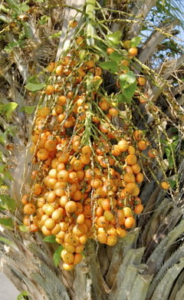 Evaluating the usefulness of the plants in your yard is a big part of permaculture; once you understand what each plant does, you will know if it is useful either to you, to wildlife or to the environment, or if it is causing harm. There are many food-producing plants that we think of as weeds or as ornamentals. Always, always, always be sure before you pop something in your mouth. So by identifying your plants you can add to your diet, and if something is already successfully growing in your yard and you can use it, fantastic!
Evaluating the usefulness of the plants in your yard is a big part of permaculture; once you understand what each plant does, you will know if it is useful either to you, to wildlife or to the environment, or if it is causing harm. There are many food-producing plants that we think of as weeds or as ornamentals. Always, always, always be sure before you pop something in your mouth. So by identifying your plants you can add to your diet, and if something is already successfully growing in your yard and you can use it, fantastic!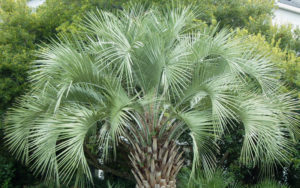 You’ve probably walked past them, or even looked askance at the dropped fruit without realizing. Also called Jelly Palms, the pindo palm is a common landscape tree for drought-tolerant hot areas. The fronds look very pokey, but are rather soft. That is a relief because once you’ve tasted the ripe fruit you’ll be thrashing through the fronds trying to pick more of them.
You’ve probably walked past them, or even looked askance at the dropped fruit without realizing. Also called Jelly Palms, the pindo palm is a common landscape tree for drought-tolerant hot areas. The fronds look very pokey, but are rather soft. That is a relief because once you’ve tasted the ripe fruit you’ll be thrashing through the fronds trying to pick more of them.Pindo palms (Butia capitata) are called Jelly Palms because the fruit has a lot of pectin in them. The trees are also called Wine Palms because you can make a cloudy wine from the fruit. But then, mankind has proven that you can make alcoholic beverages from just about anything.
The fruit is small and fiberous with a big seed, and falls to the ground when very ripe. They taste amazing. The burst of flavor is as if a pineapple and an apricot had a little yellowish baby. The best way to eat them is to gently chew the whole thing and swallow the juice, then spit out the fiber and seed.
We have two jelly palms at Finch Frolic Garden, only because they didn’t have identification we didn’t really know what they were. At the beginning of this year Miranda and I were evaluating the garden plants using the Three Positives rule (where everything in the garden has to give you three positive things. If it doesn’t, then it should be turned into hugelkultur or mulch). Several trees were repurposed and we were eyeing the palms. These palms are squat and short, not slim and tall like the very similar Queen palms. Fortunately for them, and as it turned out, for us, the trunks were too thick for my small chainsaw so we didn’t remove them with the others. This threat seemed to work because they set fruit on long stalks. We hesitantly tried one… and then just about ran each other over trying to get more!
Queen palms also produce an edible fruit that is sweeter, but is only edible when very ripe.
The fallen ripe fruit can attract bees and wasps because, well, everyone wants some. We waited until the stalks were just about completely ripe then cut them off and left them in a paper bag. The fruit then ripened and dropped off in the house where we could have them all.
Most of what I know about the Pindo Palm comes from the website Eat the Weeds by Greene Deane.
We cleaned them and froze them. Now we’re making Pindo Palm Jelly. Or maybe Jelly Palm Jelly, which sounds better.
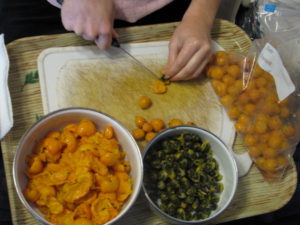 Freezing and thawing the fruit actually helps break down some of the fiber and release juices, and makes them much easier to pit. The pits are high in oil, so advice for cooking the fruit whole says the jelly can pick up bitter flavor from the seeds. We sat with trays laden with cutting boards, a knife and bowls and pitted them. Yes, this is how we spend our evenings when I’m not out dancing, processing fruit and watching a movie or reruns of the Bob Newhart show or something. Yep.
Freezing and thawing the fruit actually helps break down some of the fiber and release juices, and makes them much easier to pit. The pits are high in oil, so advice for cooking the fruit whole says the jelly can pick up bitter flavor from the seeds. We sat with trays laden with cutting boards, a knife and bowls and pitted them. Yes, this is how we spend our evenings when I’m not out dancing, processing fruit and watching a movie or reruns of the Bob Newhart show or something. Yep.The thawed fruit was easy to push away from the seed, so the process went very quickly although our fingers were pretty cold from the fruit.
We covered the pitted fruit with water and cooked it for about an hour, then strained out the fruit. There isn’t a lot of pulp because of all the fiber.
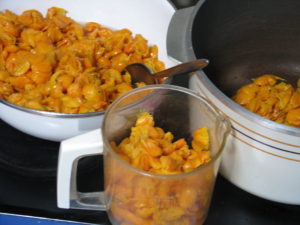 We used the National Center for Home Food Preservation’s recipe which used a lot of sugar, but the juice is so tart that it needed it.
We used the National Center for Home Food Preservation’s recipe which used a lot of sugar, but the juice is so tart that it needed it.What we got was a beautiful jelly that,despite the natural and added pectin was fairly loose. The benefit was that it can be used as a syrup as well. While the flavor of the jelly isn’t quite as astonishing as the fresh fruit, the tart tropical flavor is very good.
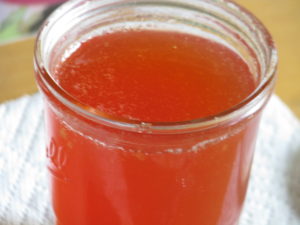
So walk around your weeds and trees and identify them, read up on them, and perhaps you can find a treasure in your yard as we have!
(We’ll be selling Jelly Palm Jelly at our annual Marketplace here at Finch Frolic Garden on Sat. Nov. 19th, 2016)
- Animals, Bees, Compost, Gardening adventures, Irrigation and Watering, Microbes and Fungi, Natives, Other Insects, Permaculture and Edible Forest Gardening Adventures, Rain Catching, Reptiles and Amphibians, Soil, Water, Water Saving, Worms
Creating Rain with Canopy
Even if we don’t receive a lot of rain in drylands, we might have fog, sprinkles and other degrees of ambient moisture. This moisture can burn off with reflected heat from hard-packed earth, from gravel and hardscape, and from buildings. It is too irregular and thin to make the use of mist nets feasible. However, a much better way to collect that moisture and turn it into rain is the method nature uses: trees. The layers of a plant guild are designed to capture, soften and sink rainwater, so why not just let them do it? Many trees are dying due to heat, low water table, lack of rainfall and dry air. Replacing them with native and drought-tolerant trees is essential to help put the brakes on desertification.
Please take five minutes, follow this link and listen and have a walk with me into Finch Frolic Garden as this 5-year-old canopy collects moisture and turns it into rain:
Plant a tree!
- Building and Landscaping, Gardening adventures, Natives, Perennial vegetables, Permaculture and Edible Forest Gardening Adventures, Water, Water Saving
Irrigation For Drylands: Conclusion
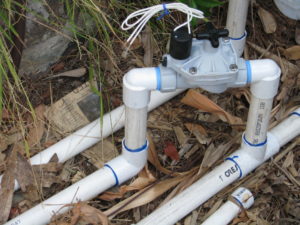
One-inch PVC runs from the valve. This is the last of the series of posts on irrigation, and I’d like to briefly address the issues of water pressure and valves. As I’ve said in a past post, if you don’t know about these things then hire someone who is an irrigation specialist (not just someone who says he’s put together irrigation before… they are guessing!). That specialist will obtain for you the right sized valves, the right irrigation timer, and monitor the water pressure so that your sprinkler heads won’t blow off and pipes break.

The one-inch pipe is then reduced to 3/4″ pipe at the first T, close to the first sprayer. For pipe, don’t use small 1/2″ pipe for large jobs. Bigger – to a point- is better. Smaller pipe doesn’t mean higher pressure. It reduces the volume of water going to the sprinklers. The smaller pipe creates more pressure loss due to friction and turbulence as the water flows through it. We took the advice of our irrigation specialist and ran 1″ pipe from the valves to the first sprinkler, and reduced it to 3/4″ pipe, then reduced for the 1/2″ risers.
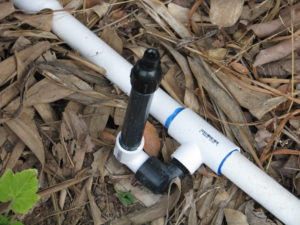
Further reducing 3/4″ to the 1/2″ sprinkler configuration. Most sprinkler systems need a water pressure of between 30 – 50 psi. Drip systems need less, around 20 psi. Too high or too low a water pressure will adversely affect your system. If you attach a water pressure gauge to a spigot you can see what your pressure is. If it is very high, you will want to check the indoor pressure as well because too high a pressure can mean pipe damage and leaks, and no one wants wet walls. You can use a pressure regulator on your line to reduce the water pressure for your irrigation.
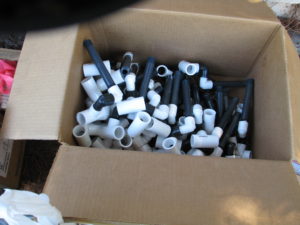 How many sprinklers you can put on a valve depends upon several factors, but mainly the flow rate, or how much water is flowing through the pipes at one time. Sprinklers have an output rate so you can do the calculations on how many you can put on a line. Flow rates are measured either in gallons per hour or gallons per minute, with gpm the most common for householders. Drip systems are less concerned with flow rate. We ended up adding valves to our system because we had so many sprinklers.
How many sprinklers you can put on a valve depends upon several factors, but mainly the flow rate, or how much water is flowing through the pipes at one time. Sprinklers have an output rate so you can do the calculations on how many you can put on a line. Flow rates are measured either in gallons per hour or gallons per minute, with gpm the most common for householders. Drip systems are less concerned with flow rate. We ended up adding valves to our system because we had so many sprinklers.When installing your system, be sure to add a ball valve (rather than a cheap gate valve) close to your water source so that if you have to work on your system you can shut it off; otherwise you’ll have to shut off the main to your outside water. If you have a large system, installing ball valves along the line to isolate different areas will help down the road if you need to troubleshoot. Having hose bibs along the line are very nice, too.
There is a lot to learn about irrigation valves – using globe valves with an expensive back-flow preventer or using anti-siphon valves that must be above ground and above the closest sprinkler head. I’m not an expert, but there is expert advice on valves here.
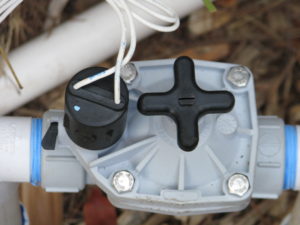
Another thing to consider is your electrical line. If you have valves, you must run electrical line to them (at this writing, solar valves are not that dependable for the long run). Electrical line must also run from your irrigation clock to your electrical source at your house. Usually electrical line is buried. Please spend the little extra money and have the electrical pulled through conduit first, rather than direct burial! Having loose wires buried in your yard is a recipe for disaster. I know this. I asked for conduit with the original system, and the wire was directly buried before I could protest. Sure enough, two years in and a valve wouldn’t turn on. The problem was with the wire… but where? How to dig it all up without nicking any of the lines? Impossible. So until this project two of my valves had to be tied together and both stations running simultaneously, which really stunted the water pressure and was a real headache. This time the conduit is run above ground along with the PVC pipe, which will be covered with mulch, and also along the top of my chain-link fence up to my house. If there are any problems, the conduit comes apart every ten feet and wires can be checked or replaced. Pulling electrical wire through conduit is not for the fainthearted; I developed new muscles and callouses working on that, but it was worth it.
Skipping ahead, your irrigation project is finished and your landscape planted. Be sure to take the time to update your plan so that it is an ‘as-built’, reflecting any changes you’ve made. This is an invaluable document not only for your own use, but for any future owners of your property or workers who might need that information. Use a rough plan of your yard and identify each valve and the area the valve covers in different colors. If you want to draw in every sprinkler head, that is fine. On large projects that isn’t practical, so just use zones. Take a waterproof marker and write the valve numbers on the valves themselves, so that you won’t become confused in the field.
Be sure to run each valve during the daytime while you inspect the sprinklers for clogging or broken heads. A lot can go wrong during the night when most systems run, and you won’t know it until you get the water bill or your plants start to die.
You may want to put in the wire for additional valves that may be added in the future. Making double valve stub-outs and only using one is far easier than pulling new electrical if you find that you need to add a valve.
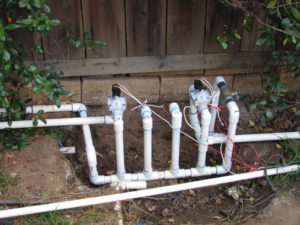
So don’t think that irrigation is a simple endeavor, and begin to glue miles of 1/2″ pipe together with 2 – 3′ risers that shoot water up embankments. This is a waste of money, plastic, water and plants. Put as much thought into your system as you put into the design of plants, and your system will give you little trouble in years to come.
Oh, and remember to shut your system off when it rains!
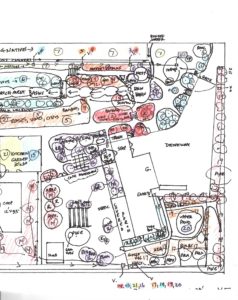 You can read Options, Part 1 of this series here, Part 2 Evaluating Your System here, and Designing Your System Part 3 here .
You can read Options, Part 1 of this series here, Part 2 Evaluating Your System here, and Designing Your System Part 3 here . - Building and Landscaping, Gardening adventures, Hugelkultur, Irrigation and Watering, Permaculture and Edible Forest Gardening Adventures, Water, Water Saving
Irrigation for Drylands, Part 3: Designing Your System

Google Maps view of property lines. Before you start buying pipe, make your design. If you are new to the property, evaluate the plants and features that exist and decide if you really want them or not. Use the ‘three positives’ rule in permaculture: everything in your yard should give you at least three positive things. For instance, you have a eucalyptus tree. It gives great shade, it is a great roost for larger birds which keep down your mice and rats, it drops lots of leaves for mulch, etc. On the ‘negative’ side, they are really thirsty and they send their roots out in search of water. They will go to the nearest irrigation and drink from there, robbing water from the tree you are trying to water. They are also allelopathic, meaning that they produce a substance that discourages many other plants from growing, or growing successfully, under or near them. Their root mass is so thick close to the surface that very few plants can survive. If planted in the wrong spot they will block views, hang over the house, drop those leaves, peels of bark and depending upon the species, heavy branches, where you don’t want them, get into overhead wires or underground leach lines, etc. They don’t make good firewood or building material, and are highly flammable. How does the tree weigh in? Usually eucalyptus are all negatives in my book. Only if they are providing the only shade and bird perches for a property are they useful. Even then I recommend pollarding them (reducing their height) and trying to ‘nursery in’ other better trees to take their place. Cut trees then should be buried, as in hugelkultur. So evaluate what you have using the three positives rule and don’t be too sentimental if you don’t like something. Do you like them? If not, cut them and bury them to fertilize plants that will serve you, and yes, aesthetics is very much a plus. If you love a particular plant, then if its possible, plant it.
If you have a property that is a blank slate, your irrigation diagram will follow your plant design. If you have an existing landscape, as I had, you need to map out where all the trees and groupings of plants are, what their water needs are and keep in mind the way water runs past these plants when you do. Use Google Maps. Type in your address, find your home and zero in on it until you can clearly see the boundries of your property.

At the bottom right hand corner of the screen is the key that show how many feet are in a measurement. This line may not always equal an inch, so measure it! At the lower right Google shows you a key for distance. There is a line with a number above it. This shows you how many feet are represented by that length. Don’t assume that the line is one inch! The line will adjust, so put a ruler up to the screen and measure it. I zoom out until the line is an inch long, and take that number; its just easier to compute distances using an inch rather than a fraction. You can print that diagram of your property line, which will show you which way your house sits on the property.

Satellite view of Finch Frolic Garden. This helps to map groupings of vegetation. I have a PC, so I press the PrntScr (print screen) key, paste it onto a paint.net screen, crop off the extra bits and print that. Now you have something to work with. I double or triple the size of the drawing onto a larger sheet; this can be done easily with a ruler, using the printed sheet to guide your angles.
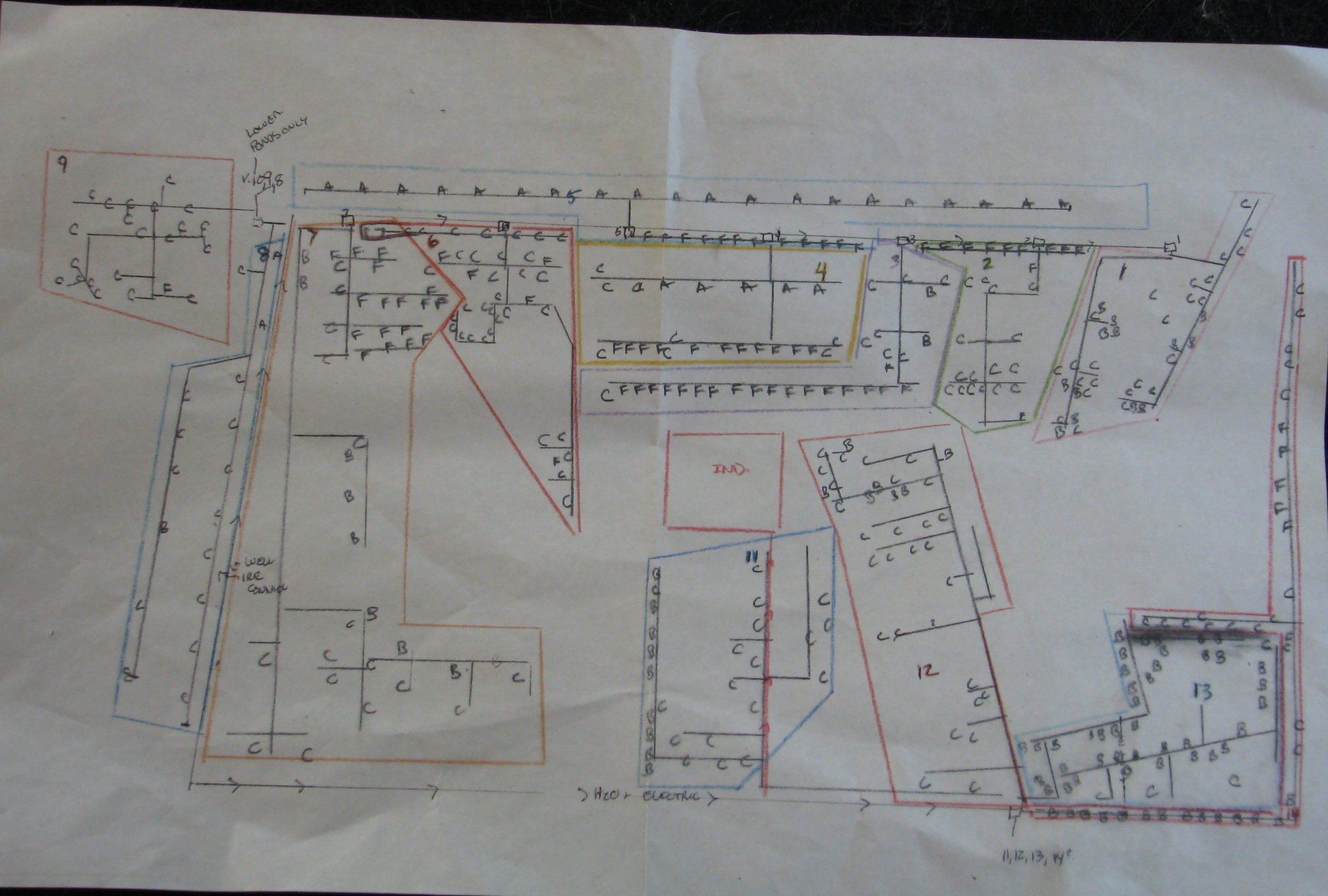
A projected irrigation plan for Finch Frolic Garden. What you actually put in may differ. Make a couple of copies of this template, and then use one to start drawing.
When you have the plants down on paper, then start with the irrigation. Determine where your water main is, and where any valves and hose bibs are around your house. If you only have domestic water to choose from, you’ll be coming from a domestic line.
Fifteen to twenty sprayers are good per valve. I’m not talking about high-pressure nozzles that shoot water all over the place; these you want to eliminate. Most of that water is evaporated.
The sprinklers that we installed have a spray of up to 4 feet, and can be reduced down to a drizzle.
These are what we installed here:


The 3/4″ T was glued in facing sideways rather than straight up. A black Street 90 and a white Street 90 were screwed into the T, firmly but with enough leeway to turn if pushed. Black ones don’t need pipe tape because they are soft and self-seal. The risers (nipples) are 6″, and were taped at both ends before screwing into the Street 90. (You don’t put the heads on yet because you’ll want to ‘blow’ out your system with water to clean the pipes beforehand. )

These risers can bend! With this configuration the risers are resistant to damage from being kicked, from having 100-lb. tortoises crawling over them, etc.

Gamera enjoying the movable sprinklers. They can be moved in all directions so that you can deliver water closer to small rooted new plants, then move them away as the root ball grows. If you have the assembly ready when you glue in the T, then you won’t have to struggle to screw it on. Ends will have a slip/thread elbow glued sideways with the same assembly.
There are lots of sprinkler heads out there. These sprayers have threaded ends rather than barbed, so that they stay in place rather than be blown off. These are 360 degree sprayers; you can obtain threaded sprayers for 180 and 90 degree, and probably other configurations as well.

A 180 degree head. Notice all the white? That is mineral deposit, and the sprinkler has run only about 10 -15 times. Don’t forget the filter. A filter in every head saves you a lot of grief with plugged heads and poor irrigation down the line. They are easy to clean.
Next post: Concluding the project.
You can read Part 1 Options here, Part 2 Evaluating Your System here, and Part 4 Conclusion here.
- Building and Landscaping, Gardening adventures, Hugelkultur, Permaculture and Edible Forest Gardening Adventures, Rain Catching, Recycling and Repurposing, Soil, Water, Water Saving
Irrigation for Drylands, Part 1: Options
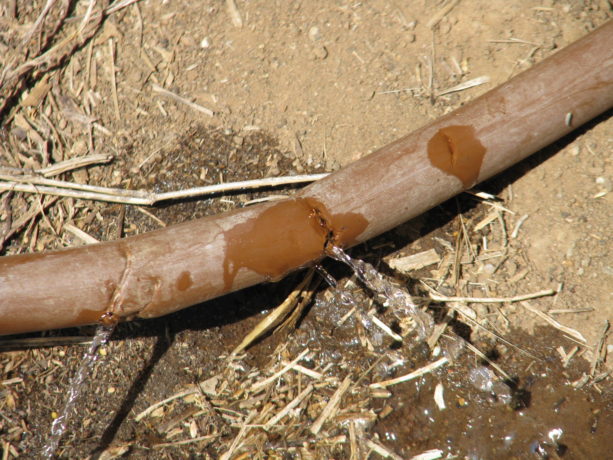
This tubing is so easily nicked that weeding around it often results in a bad leak that isn’t detected for awhile. Leaks cause flooding with dry areas past them on the line. A previous draft of this post was about 2,000 words of mostly rant against Netafim, so I’m starting over trying to be more helpful. You’re welcome.
In Southern California, and many dryland areas, if you are to grow food crops you have to irrigate. I have met several people who believe that they can ‘dry farm’ crops such as grapes here, and that is problematic. Even in Central California where they receive many inches more rain than we do, farmers struggle in the long hot, dry summers.
There are many ways to water, and I’ll address as many as I can.
The first and most important step for irrigating your property is installing the earthworks that will harvest what rain we do receive and allow it to percolate into the soil. Paring that with burying wood and other organic material to hold that water, planting in shallow depressions rather than on raised mounds and sheet mulching will greatly increase the health of your plants and decrease your water bill.
For delivering captured or purchased water you’ll need some kind of tubing and a force to deliver the water. We’ll discuss the natural methods first:

Ollas (oy-ahs) should have a lid or stone or something to block the top, to keep creatures from falling in and drowning. Photo from link page. For small yards, or for orchards with lots of labor, burying ollas (porous clay pots) in the center of a planting area is a wonderful idea. There is a really good article with diagrams and suggestions here. You can manually fill the ollas by carrying water to them (the best would be from rain barrels), or dragging a hose around to fill them. Or they can be combined with a water delivery system of pipes as discussed below. Water is then drawn through the porous pots by the dry soil around them, and thus to plant roots. There is a tutorial about making inexpensive ollas from small clay pots, and interesting comments, here. There are problems, but then, there are problems with everything. Clay pots can break, especially if you have soil that freezes or foot traffic. A larger pot doesn’t mean that water will be delivered farther underground; absorption is based on soil density. This is a system that you need to monitor and replace periodically. On the plus side, clay is natural and will decompose in the soil. Many years ago, long before I ‘discovered’ permaculture, I buried gallon milk jugs in which I punched small holes by some trees beyond any irrigation pipes. I didn’t know about ollas then; I just thought it was a good idea to get water close to the roots of the plants. This really worked and those trees are mature and still exist almost thirty years later, and still don’t have irrigation to them. However, I found that the plastic milk jugs become brittle and break apart, as will plastic soda bottles, and you really don’t want to bury plastic. Clay is much better.

Clay pipe photo from Permanomades. Please follow link to website. These look very large, but are not. Next would be delivering water via some kind of pipe. Clay pipes are the most natural, but unless you have the clay, the labor and the time to create lots of long, hollow clay pipes, this is a pricey option. Clay pipes break easily, too.

Split bamboo delivers water downhill. Photo from link page. If you have lots of bamboo you can season it, split it, remove the nodes (partitions) and then mount it to deliver water to individual plants, to ollas, or to swales. Again, you need time, bamboo, labor and some expertise. There is a good article about it here.
Plastic:
There are a lot of plastic pipes out there, and although I hate to invest in more plastic, it is often a necessary evil. Drip irrigation comes in many forms. There are bendable tubes that ooze, tubes that have holes spaced usually 12″ or 24″, tubes that can be punctured and into which spray heads are inserted, and tubes which can support spaghetti strands that are staked out next to individual plants. The popularity of drip irrigation has been huge in water-saving communities. Unfortunately they have lots of problems. Here I’ll indulge in just a little rant, but only as an illustration.
One of the big problems with flexible tubing in arid areas is the high mineral content of the water and what it does to these tubes. Any holes -including those in small spray heads- will become clogged with minerals.
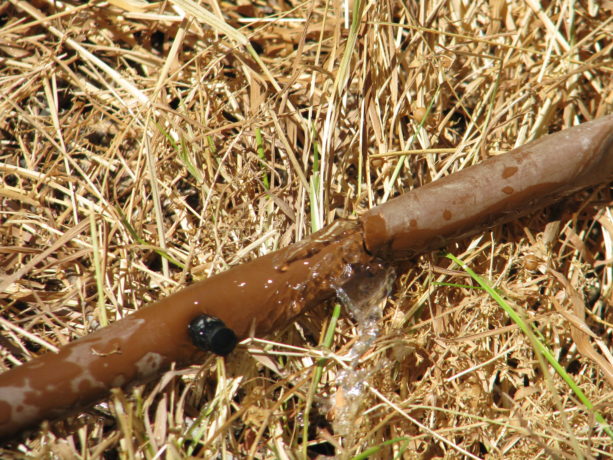
A nozzle that is clogged next to a hole that is not. Flushing the system with vinegar works for a short time, but eventually the minerals win. If the tubing is buried, then it is virtually impossible to discover the blocked holes until plants begin to die. Tubing above ground becomes scorched in the sun and breaks down.
Also, flexible tubing is extremely chewy and fun with a little drink treat as a reward.
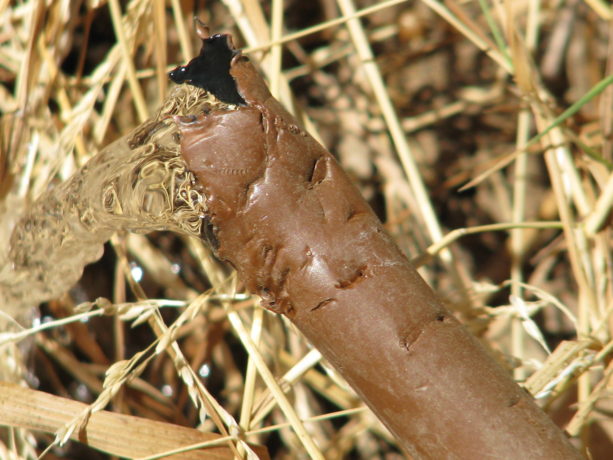
Coyotes and many other animals find flexible pipe so fun to chew. This is the opinion of gophers (who will chew them up below ground and you won’t know unless you find a flood or… you guessed it… dying plants), coyotes (who will dig the lines up even if there is an easier water source, because tubing is fun in the mouth), rats (because they are rats), and many other creatures. Eventually a buried flexible system will be overgrown by plant roots, will kink, will clog, will nick (and some products such as Netafim seem to nick if you even wave a trowel near it), and will be chewed. Some plants will be flooded; others will dry up. You will have an unending treasure hunt of finding buried tubing and trying to fix it, or sticking a knife point into the emitter holes to open them up and then having too much water spray out.
Plus, drip irrigation is not good for most landscape plants. Most woody perennials love a good deep drink down by their roots, and then let go dry for a varying time depending upon the species, weather and soil type. Most native California plants hate drip irrigation. According to Greg Rubin, co-author along with Lucy Warren of The California Native Landscape (Timber Press; March 5, 2013) and a San Diego native landscaper, native plants here enjoy an overhead spray such as what a rain storm would deliver. Some natives such as Flannel Bush (Fremontia) die with summer irrigation and are especially intolerant of drip. Drip is most appropriate with annuals or perennials that have very small root bases and that require regular watering. Small root balls are closer to the hot surface and will dry up more quickly. Vegetables, most herbs and bedding plants can use drip. Plants that have fuzzy leaves that can easily catch an air-born fungal disease such as powdery mildew are better watered close to the ground rather than with an overhead spray of chlorinated water.
Then there is PVC, the hard, barely flexible pipe that is ubiquitous in landscaping for decades. PVC is hard to chew, can be buried or left on the surface if covered with mulch (to protect from UV rays), is available in a UV protected version if you want to spend the extra money and still give it some sun protection, utilizes risers with larger diameter water deliver systems such as spray heads, bubblers, and even drip conversion emitters that have multiple black spaghetti strands emerging from them like some odd spider.
At Finch Frolic Garden I had taken advice to install Netafim, a brown flexible tubing with perforations set 12″ apart, which was buried across the property from each valve box. It has been a living nightmare for most of that time. Besides all the reasons that it could fail (it did all of them) listed above, it also at its best delivered the same amount of water to all of the plants no matter what their water needs. It was looped around most trees so that the trees would receive more water, but since then roots have engulfed the tubing, cutting off the water flow. There are areas with mysterious flooding where we can’t trace the source without killing many mature plants.
Over the past year we’ve lost about 1/4 of our plants including most of our vegetables, because we plant where there should be water, and then mysteriously, there isn’t any. Flushing with vinegar helped a little, but whatever holes are still functioning are closing up with mineral deposits. Okay, I’m ranting too much here. But this was an expensive investment, and an investment in plastic, that has stressed me and my garden. So upon weighing all my alternatives I’ve decided to install above-ground PVC with heads on risers that either spray or dribble, and the dribblers will go into fishscale swales above plants.
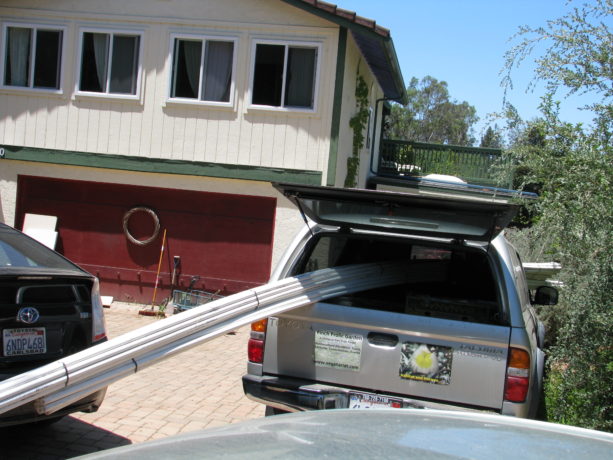
Twenty-foot lengths of PVC can fit in the Frolicmobile, and sure beats carrying it down the property. In the next few posts in this series I will talk about how to draw up an irrigation plan, installation, valves and other watering options, as Miranda and I spend our very hot summer days crawling through rose bushes and around trees gluing, cutting, blowing out and adjusting irrigation. Thanks for letting me vent.
You can read Part 2 Evaluating Your System here, Designing Your System Part 3 here , and Part 4 Conclusion here.
-
Ducklings!
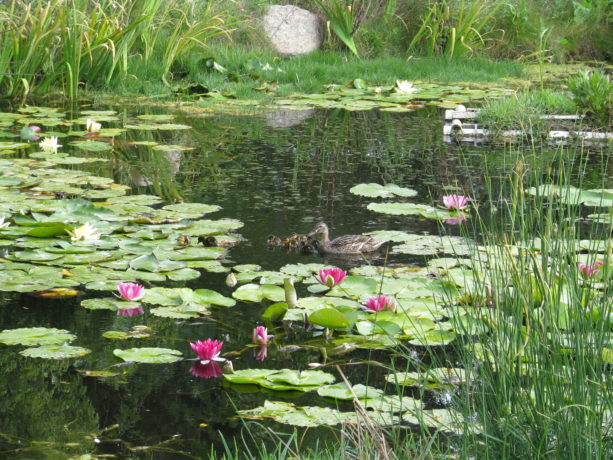
Mrs. Mallard returned today, introducing her very young ducklings to our pond! Mrs. and Mr. Mallard really love our pond, and have adopted us for several years. She had tried to nest on land here, even up by our garage which is a long walk from the pond, but the eggs were always destroyed in the night. Last year she returned with four young, which all disappeared quickly. They were probably food to bullfrogs, birds, rats or other creatures. It was very sad.
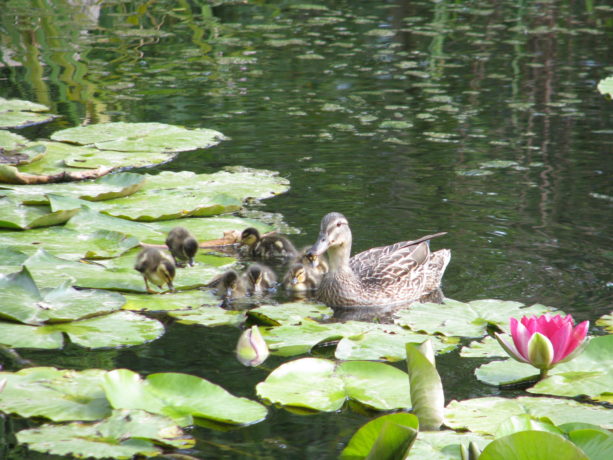
Some are standing on lily pads!!! This year Mrs. Mallard went through her usual breeding time with Mr. Mallard, then disappeared, and then reappeared without ducklings. We figured that her brood hadn’t been successful and that was that for this year. Mr. Mallard has been losing his mating plumage, and she hadn’t been visiting. Miranda and I figured that she was enjoying herself elsewhere. Today as I worked outdoors I passed by the pond and to my astonishment there was Mrs. Mallard and seven adorable ducklings! These babes are only a few days old. She would have had to lead them walking from wherever her nest was, and somehow navigate a chain-link fence! At first she was cautious because I was talking to her excitedly and taking photos.
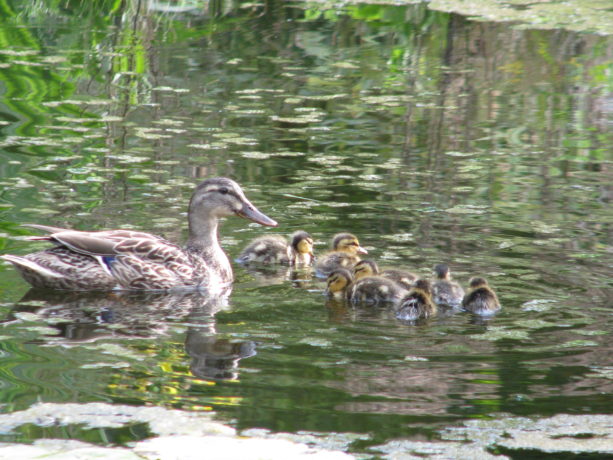
She watched me carefully, but then decided I was still safe and led them ashore. I calmed myself down and went about my work, and on one of my trips past the pond she gave me a decided look and then quickly led her brood out of the big pond just in front of me and paraded them across to the little pond. The babies had their first sample of duckweed.
Mrs. Mallard and Ducklings
Mrs. Mallard decides I’m still a friend and leads her ducklings from the big pond to the small pond at Finch Frolic Garden. I think she was showing her firs…
As these ponds have no chemical treatments, are topped off with rain and well water and cleaned by the plants and fish, the water is wonderful for wildlife. They can bathe, eat and drink without ingesting or absorbing chemicals. Good water is as microbially diverse as good soil, and all those microscopic critters are food, protection and healthy flora for all the creatures that flock to these ponds.
Later I noticed her crouched in the bog by the big pond, with all of her young out of sight underneath her. I looked around for a predator, but saw that Mr. Mallard was on the duck island and she was uncertain of him. I stood watching them, ready to protect her. Finally he noticed her, and all went well. A little later they were sitting together, still with no babes in sight.
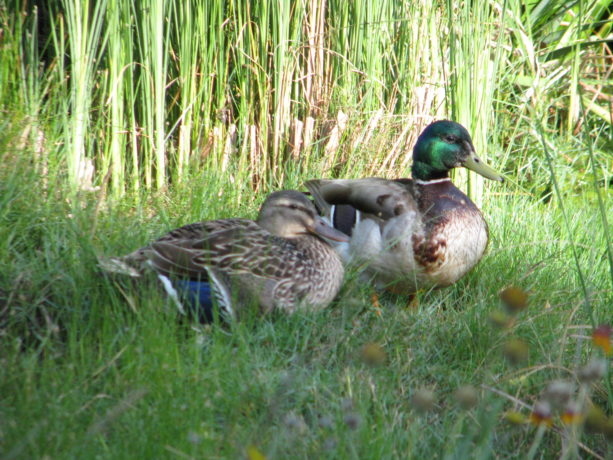
The ducklings are safely tucked under mama in case dad has other ideas. I heard him fly off, probably to join some other males for some companionship.
Mrs. Mallard led her young across the pond and right to the floating duck island that is anchored in the middle of the pond.
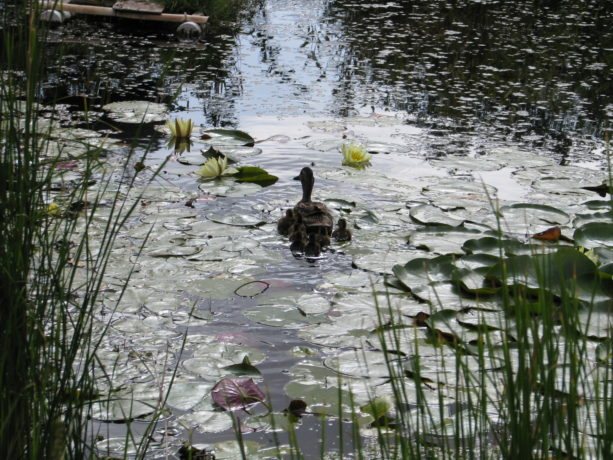
Mrs. Mallard heads for the duck island for the evening. Smart mama! This island has a board down the middle and loose plants stuck in without soil. It is a remediation float as well, cleaning the water as it floats.

Everything is so new, especially this island! Miranda and I were worried that the little ducklings wouldn’t be able to get aboard the raft, but they had no trouble.
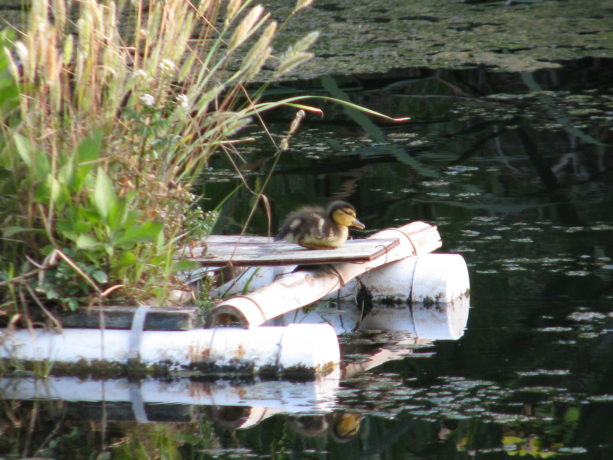
This little one is so tempted to get back in the water, but he or she resists. Its been a tiring day. 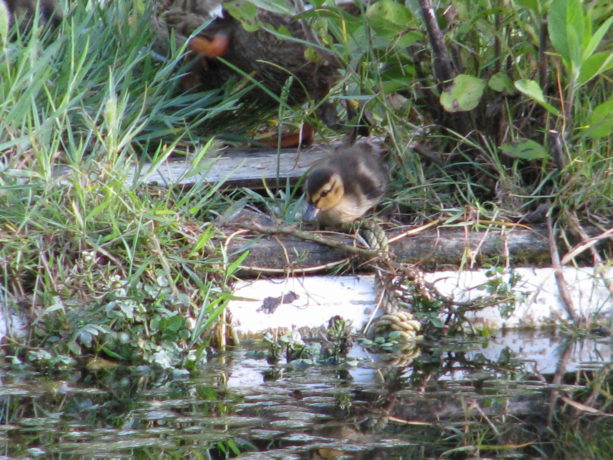
Taking a last longing look at the water, which he only learned the existence of today. 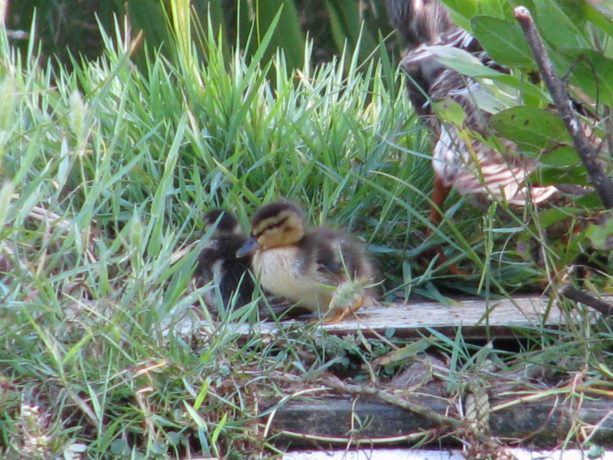
The ducklings are in an array of colors, from light yellow and grey to all dark. 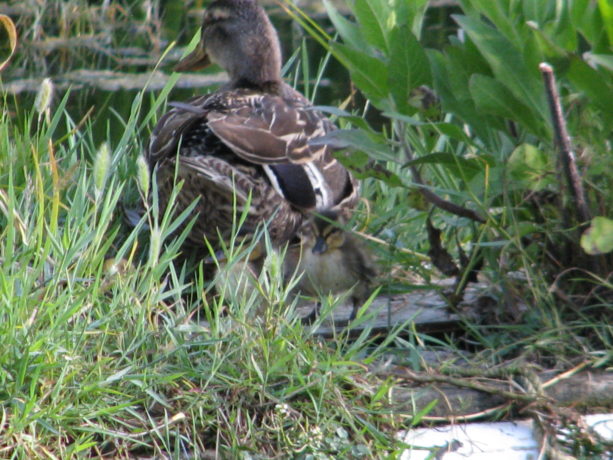
Almost everyone is tucked under for the night. After exploring a little, falling off a few times and grooming themselves, they tucked under their very good mama for a warm and safe sleep. Squeee!
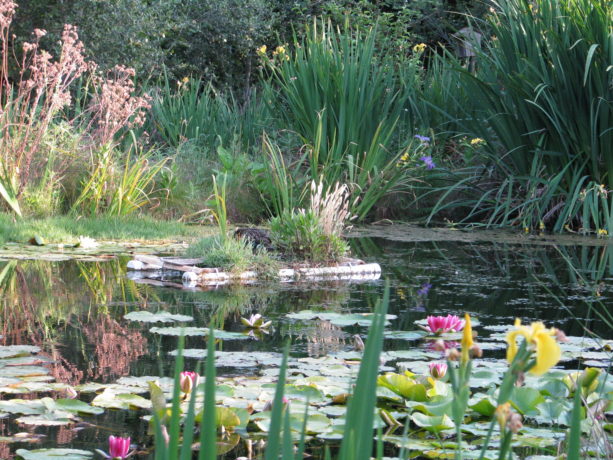
Safely afloat, Mrs. Mallard and children are tucked away for the night, safe from coyotes, raccoons, rats and snakes.



